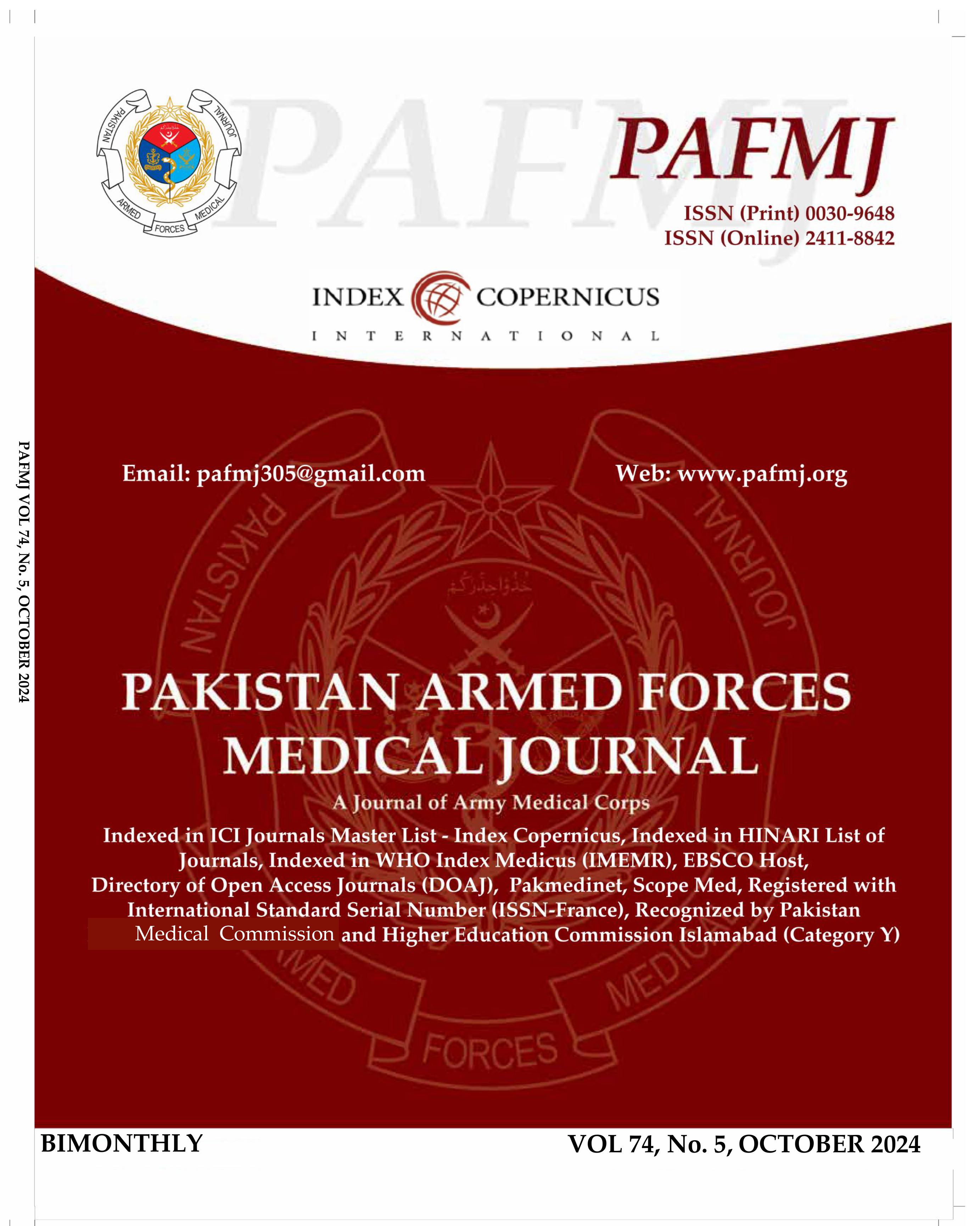Serum Vitamin D Testing – A Necessity Or An Injudicious Expenditure
DOI:
https://doi.org/10.51253/pafmj.v74i5.11656Keywords:
Cost-Effectiveness, Vitamin D, Vitamin D Deficiency, Vitamin D Supplementation.Abstract
Objective: To evaluate the serum vitamin D levels and to determine the justification for vitamin D testing in patients.
Study Design: Cross-Sectional study.
Place and Duration of Study: Department of Chemical Pathology, Armed Forces Institute of Pathology Rawalpindi, Pakistan from Oct to Dec 2022.
Methodology: Patients of either gender coming for vitamin D level estimation were included. Vitamin D levels were analyzed on Immunoassay auto-analyzer. Data was analyzed using SPSS version 26.
Results: Out of 249 patients, 87(34.9%) were male while 162(65.1%) were female, with mean age 41.09±19.10 years and mean Vitamin D levels 73.08±45.86nmol/l. None of the patients (0%) had vitamin D deficiency, 174(69.9%) had vitamin D insufficiency, 72(28.9%) had vitamin D sufficiency, while 3(1.2%) had vitamin D excess. Major reasons for Vitamin D testing was bone pains, which were present in 72(28.9%) patients. A significant difference in vitamin D levels according to reason of testing (p<0.05) was observed. Total expense on vitamin D testing for 249 patients was PKR 722100/- (249x2900), as compared to cost of supplementation PKR 199200/- (249x800) in clinical suspected cases.
Conclusion: Majority of patients that tested for vitamin D were in lower risk group, and were not vitamin D deficient, with bone pains being the complaint due to which most patients were tested.
Downloads
References
1.Giustina A, Adler RA, Binkley N, Bollerslev J, Bouillon R, Dawson-Hughes B, et al. Consensus statement from 2nd International Conference on controversies in vitamin D. Rev Endocr Metab Disord 2020; 21(1): 89–116. http://doi.org/10.1007/s11154-019-09532-w
2.Bouillon R, Marcocci C, Carmeliet G, Bikle D, White JH, Dawson-Hughes B, et al. Skeletal and extraskeletal actions of vitamin D: Current evidence and outstanding questions. Endocr Rev 2019; 40(4): 1109–1151.
http://doi.org/10.1210/er.2018-00126
Janoušek J, Pilařová V, Macáková K, Nomura A, Veiga-Matos J, Silva DD, et al. Vitamin D: sources, physiological role, biokinetics, deficiency, therapeutic use, toxicity, and overview of analytical methods for detection of vitamin D and its metabolites. Crit Rev Clin Lab Sci 2022; 59(8): 517–554. http://doi.org/10.1080/10408363.2022.2070595
Borel P, Caillaud D, Cano NJ. Vitamin D bioavailability: state of the art. Crit Rev Food Sci Nutr 2015; 55(9): 1193–1205. http://doi.org/10.1080/10408398.2012.688897
Essig S, Merlo C, Reich O, Trottmann M. Potentially inappropriate testing for vitamin D deficiency: a cross-sectional study in Switzerland. BMC Health Serv Res 2020; 20: 1-8. https://doi.org/10.1186/s12913-020-05956-2
Amrein K, Scherkl M, Hoffmann M, Neuwersch-Sommeregger S, Köstenberger M, Tmava Berisha A, et al. Vitamin D deficiency 2.0: an update on the current status worldwide. Eur J Clin Nutr 2020; 74(11): 1498–1513.
http://doi.org/10.1038/s41430-020-0558-y
Hofstede H, van der Burg HAM, Mulder BC, Bohnen AM, Bindels PJE, de Wit NJ, et al. Reducing unnecessary vitamin testing in general practice: barriers and facilitators according to general practitioners and patients. BMJ Open 2019; 9(10): e029760. http://doi.org/10.1136/bmjopen-2019-029760
Vitamin D. South Tees Hospitals. NHS Foundation Trust;2021. [Internet]. Available at:
https://www.southtees.nhs.uk/services/pathology/tests/vitamin-d/ (Accessed on December 8, 2022)
Rockwell MS, Wu Y, Salamoun M, Hulver MW, Epling JW. Patterns of clinical care subsequent to nonindicated vitamin D testing in primary care. J Am Board Fam Med 2020; 33(4): 569–579. http://dx.doi.org/10.3122/jabfm.2020.04.200007
Rockwell MS, Wu Y, Salamoun M, Hulver MW, Epling JW. Patterns of clinical care subsequent to nonindicated vitamin D testing in primary care. J Am Board Fam Med 2020; 33(4): 569-579. https://doi.org/10.3122/jabfm.2020.04.200007
LeFevre ML. Screening for vitamin D deficiency in adults: U.S. Preventive Services Task Force recommendation statement. Ann Intern Med 2015; 162(2): 133–140.
https://doi.org/10.7326/M14-2450
Holick MF, Binkley NC, Bischoff-Ferrari HA. Evaluation, treatment, and prevention of vitamin D deficiency: an Endocrine Society Clinical practice guideline. J Clin Endocrinol Metab 2011; 96: 1911–1930. https://doi.org/10.1210/jc.2011-0385
Excellus: low value vitamin D testing in upstate NY. [Internet]. Available at:
https://www.bcbs.com/news/press-releases/most-people-dont-need-vitamin-dtesting. (Accessed on December 8, 2022)
Rozario NL, Sparling A, Burns R. Modifying provider vitamin D screening behavior in primary care. J Am Board Fam Med 2020; 33(2): 252–261. https://doi.org/10.3122/jabfm.2020.02.190323
Zuberi LM, Habib A, Haque N, Jabbar A. Vitamin D Deficiency in ambulatory patients. J Pak Med Assoc 2008; 58(9): 482–484.
Essig S, Merlo C, Reich O, Trottmann M. Potentially inappropriate testing for vitamin D deficiency: a cross-sectional study in Switzerland. BMC Health Serv Res 2020; 20(1): 1097. http://doi.org/10.1186/s12913-020-05956-2
Woodford HJ, Barrett S, Pattman S. Vitamin D: too much testing and treating? Clin Med 2018; 18(3): 196–200. http://doi.org/10.7861/clinmedicine.18-3-196
Pludowski P, Takacs I, Boyanov M, Belaya Z, Diaconu CC, Mokhort T, et al. Clinical practice in the prevention, diagnosis and treatment of vitamin D deficiency: A central and eastern European expert consensus statement. Nutrients 2022; 14(7): 1483. http://dx.doi.org/10.3390/nu14071483
Downloads
Published
Issue
Section
License
Copyright (c) 2024 Athar Iqbal Paracha, Muhammad Qaiser Alam Khan, Muhammad Younas, Zujaja Hina Haroon, Muhammad Anwar, Muhammad Usman Munir

This work is licensed under a Creative Commons Attribution-NonCommercial 4.0 International License.















